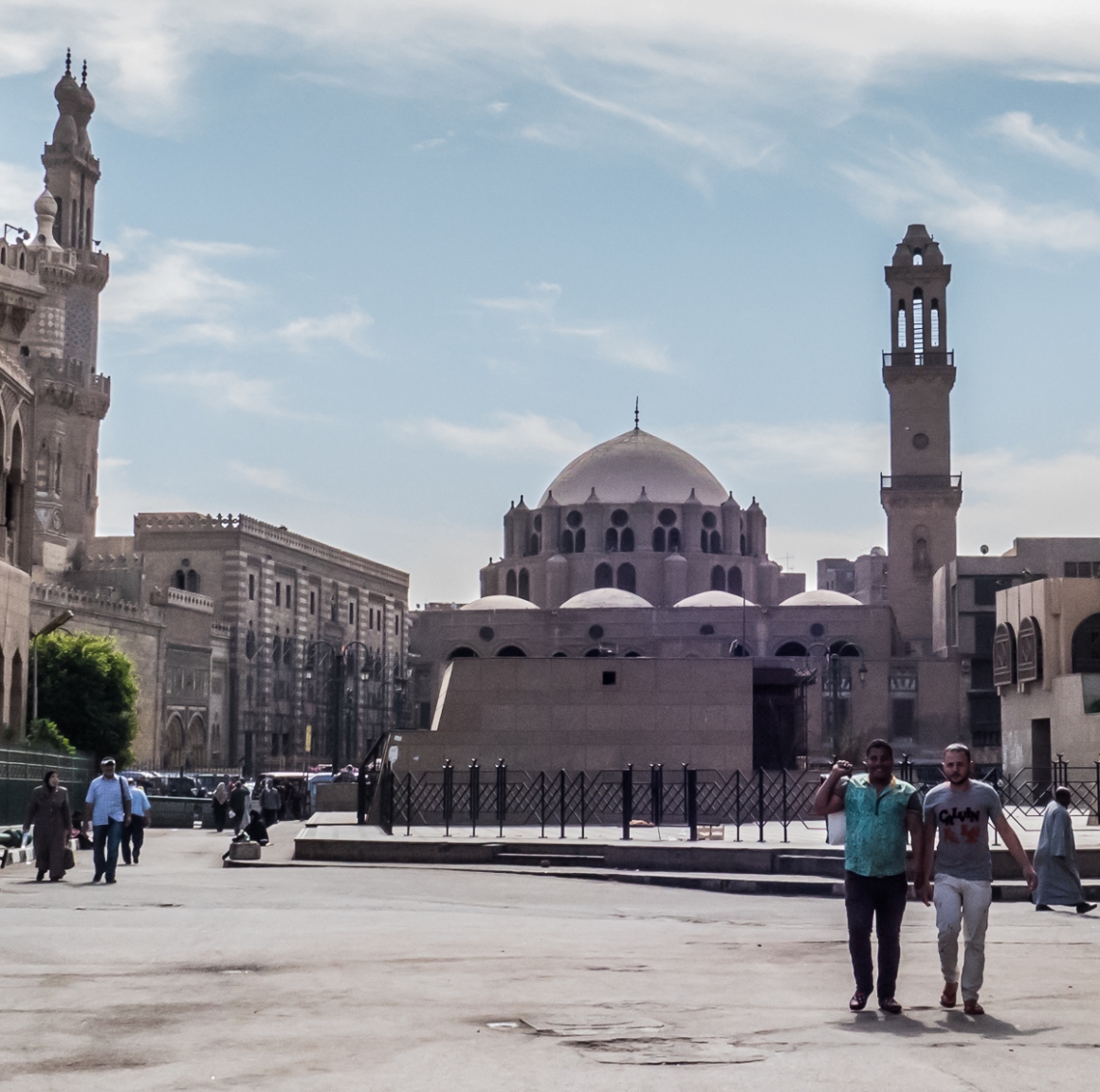
Come with me on a journey through the streets of Cairo. It is one of the oldest cities in the world, and one of the biggest, teeming with life, with history, with ideas, inspiration, kindness and suffering, wealth, poverty and greed. It is all things, all you could want it to be and all you wish it wasn’t. It is one of the most densely populated cities in the world.

There are over twenty million people all vying for space, over twenty million people walking it’s weary streets, over twenty million stories unfolding, over twenty million stories intertwined in a chaotic web of life. It is smothering. It is exhilarating. It never stops. Egyptians call it Umm ad-Dunya: the Mother of the World.
From the van while driving to the pyramids, and to the museum, and in and out of town to Alexandria and back, we get glimpses of these stories: school girls,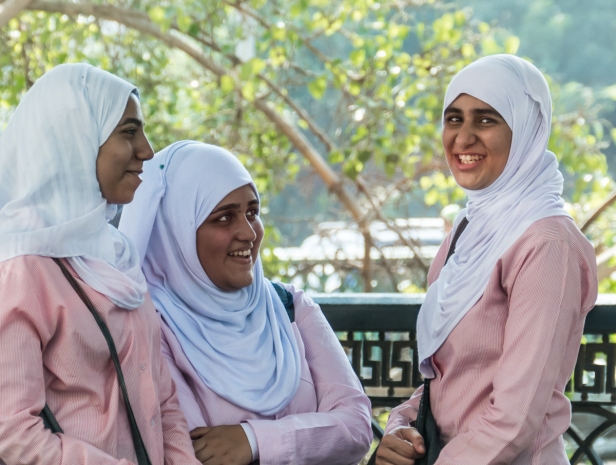
and veiled women rushing,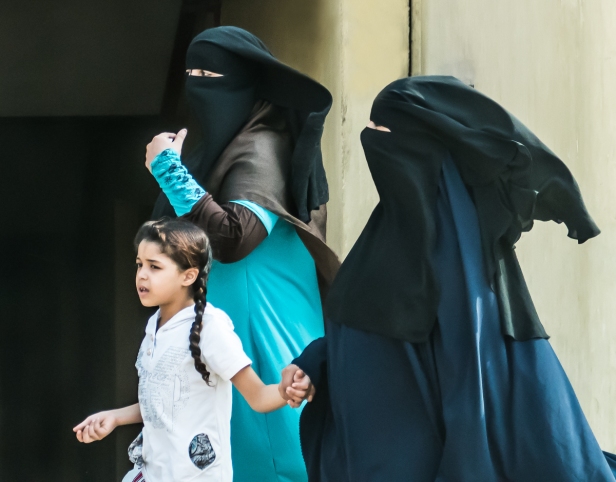
the man selling yams,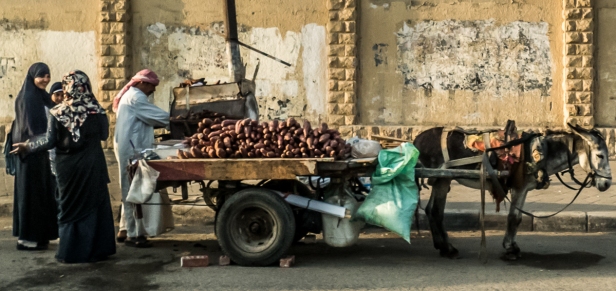
and the couple selling corn.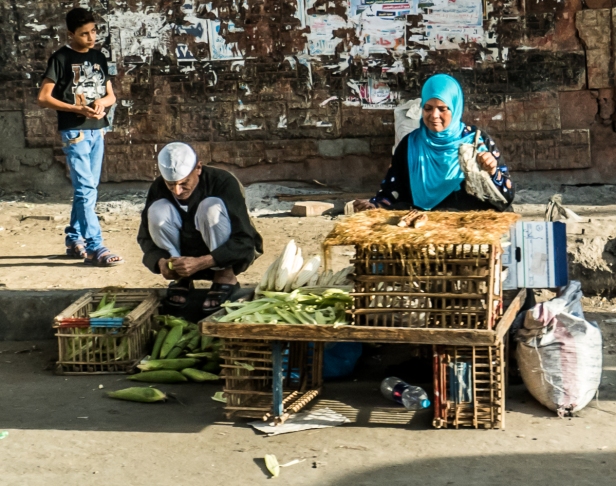
They are next to a busy main road under the dual overpass of a freeway, which doesn’t live up to its name. There are 5 million cars in Cairo. Add to that there are motorbikes, tuk tuks, buses, horse carts, and donkey carts.
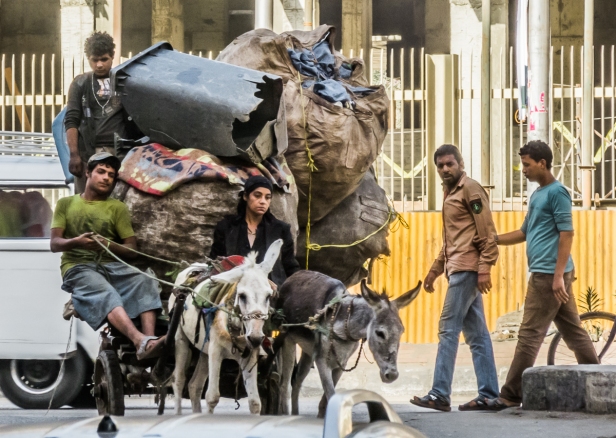
The traffic is unkempt, insistent, ruthless, and frightening. The freeways and the ring road are wall-to-wall traffic; there is nothing free about them. Cairenes spend a significant part of their lives stuck in traffic. It has become a place to socialize, to hang out with friends, and to trade insults with fellow drivers. The blaring of horns is relentless. Traffic laws are largely ignored.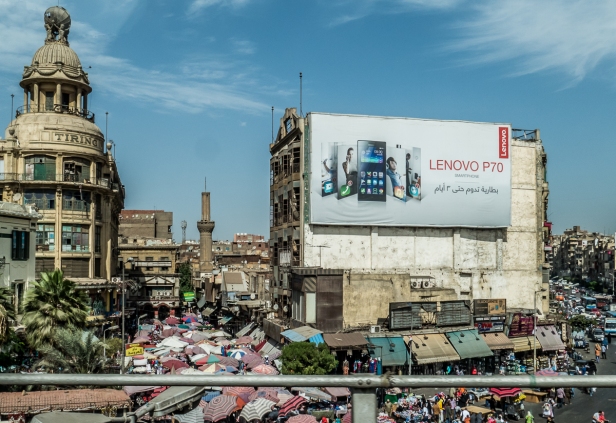
And now we leave the snarling traffic behind and walk through the part of town known as Islamic Cairo, the medieval heart of the city. Breathing comes easier, and we start to relax in the spaciousness of pedestrian-only streets.
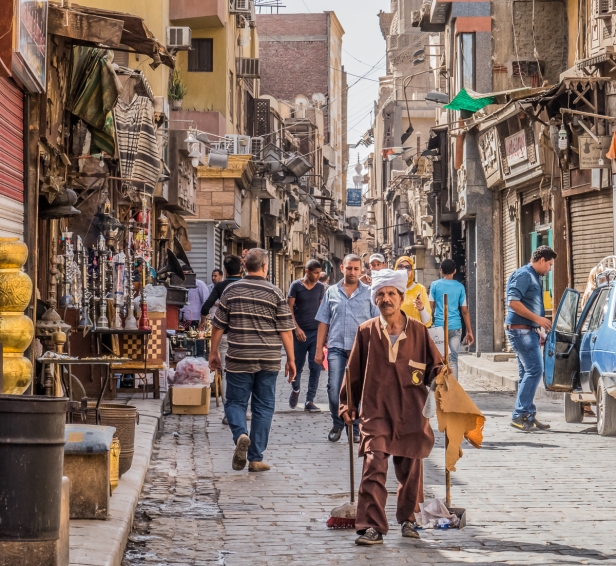
The buildings have the patina of age, and the beauty of a time when architecture was about more than cost and function.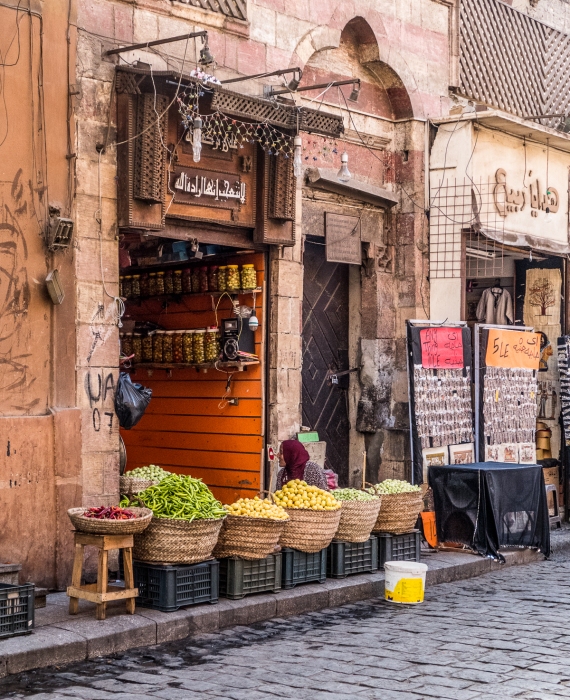
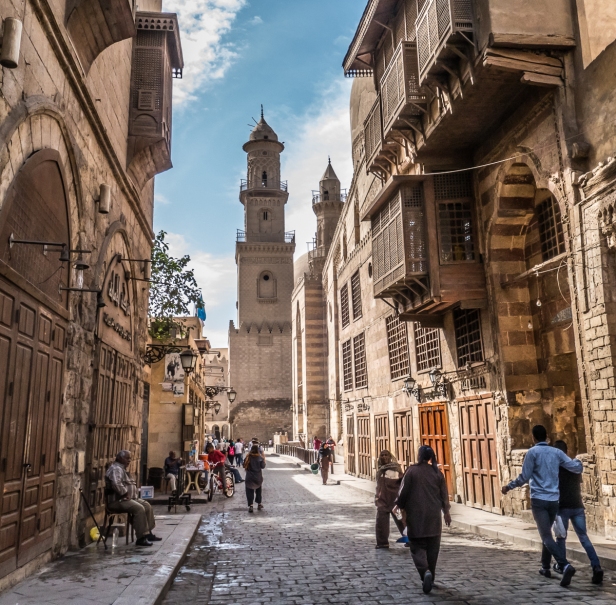

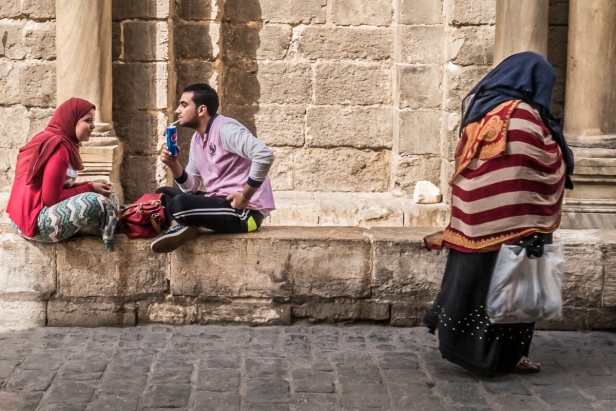
First to Al-Azhar Mosque
where all the women must don robes and head scarves in order to be allowed to enter. The main entrance opens into the vast white marble-paved courtyard.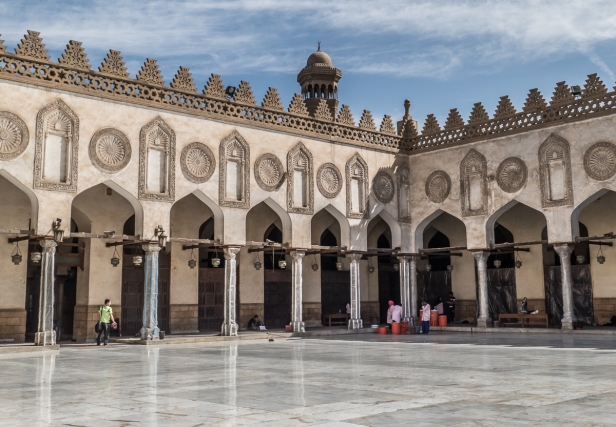
Inside a young boy contemplates the Koran. Or perhaps it is his cell phone. Or the Koran on his cell phone.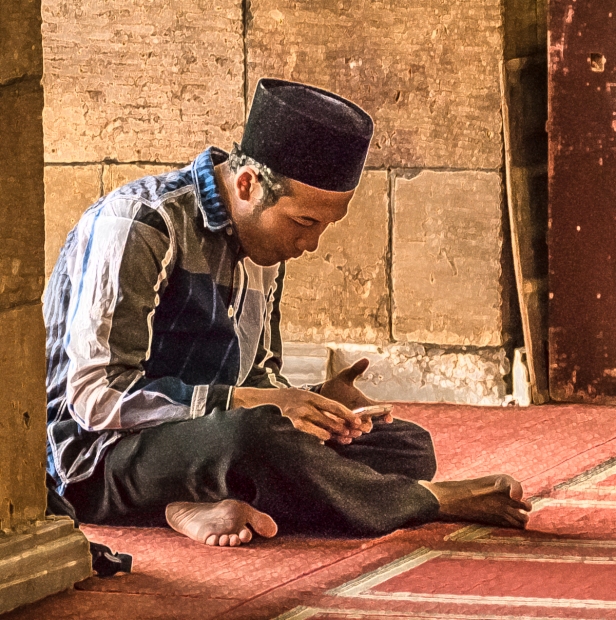
Al-Azhar Mosque is one of the oldest operating universities in the world, and is the oldest and biggest in the Islamic world.
From the mosque we walk to Cairo’s enormous market, or souk, known as Khan al-Khalili. Khan al-Khalili was built in the 1300’s and is still frequented as much by locals as by tourists. It is a rabbit warren of tiny pedestrian alleys and lanes,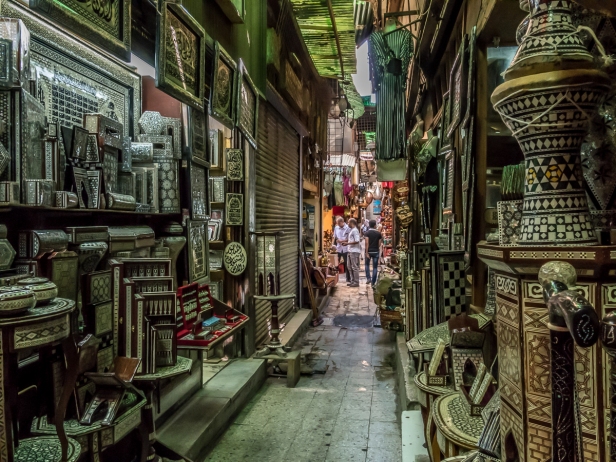

a huge conglomeration of stores, selling everything from metal ware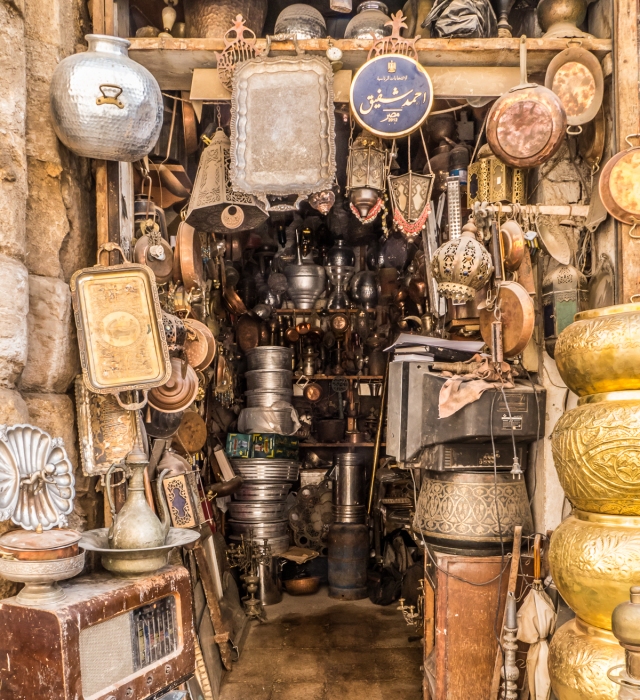
to clothing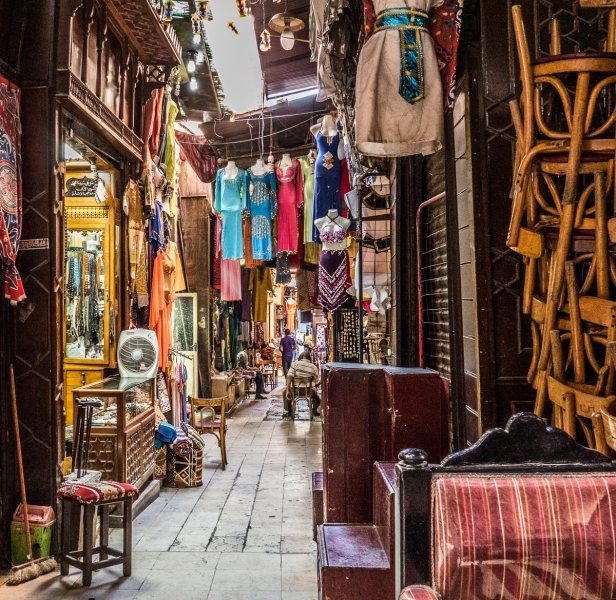
to stone carvings,

dolls,

semiprecious stones, water pipes, soap powder, toy camels, carpets, books and magazines, alabaster pyramids, furniture, and spices.
Almost anything can be bought here.
No one hassles us as we explore.
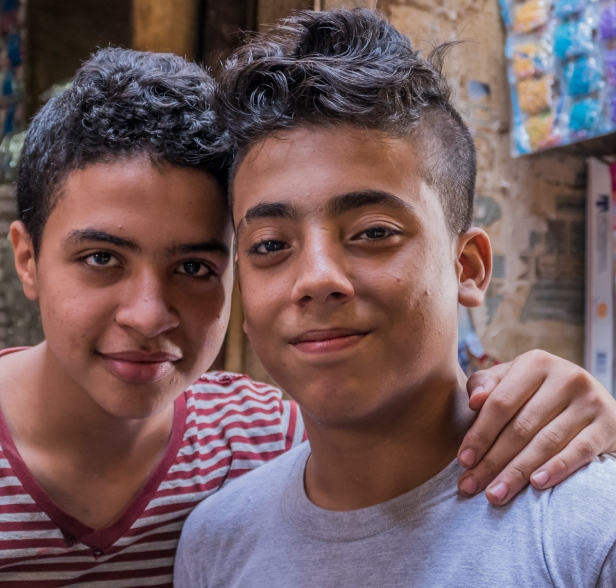
Perhaps they sense we are only here to look. But they do say hello, and ask where we’re from. All throughout Egypt hawkers cry out to us “Where are you from” in a bid to get our attention. When we reply “Canada” their immediate response is “Canada Dry!” I’m sure they don’t even know what it is. I think it may be the only words they have ever heard about Canada. For all you non-Canadians, Canada Dry is a sparkling ginger flavoured soft drink very much like ginger ale.
And now it’s time for a break, so naturally we go to the famous Al-Fishawy Café, the oldest coffee house in Cairo. Begun more than 240 years ago by one Mr. Al-Fishawy, this smoky, mirrored cafe was originally a simple stall serving coffee to the vendors in the labyrinthine souk.
It gradually expanded to include water pipes and tea,
and today has become a Cairo institution, a welcoming reprieve where locals and tourists alike stop for the atmosphere, the old-school ways, and of course for coffee, tea, and tobacco. It is owned and run today by the seventh-generation of Al-Fishawys, and is mostly a café for ordinary people: cabbies and shopkeepers, students, and worshippers after evening prayers. And late into the evening there can be spontaneous performances of poetry or music. Everyone likes to hang out here.

We are served quickly and sit drinking hot coffee and steaming mint tea while watching the life around us. I see two women reflected in one of the many mirrors. I watch and photograph them for a while as they smoke their flavoured hookahs. Then suddenly one of them catches me and I’m rewarded with a sweet smile.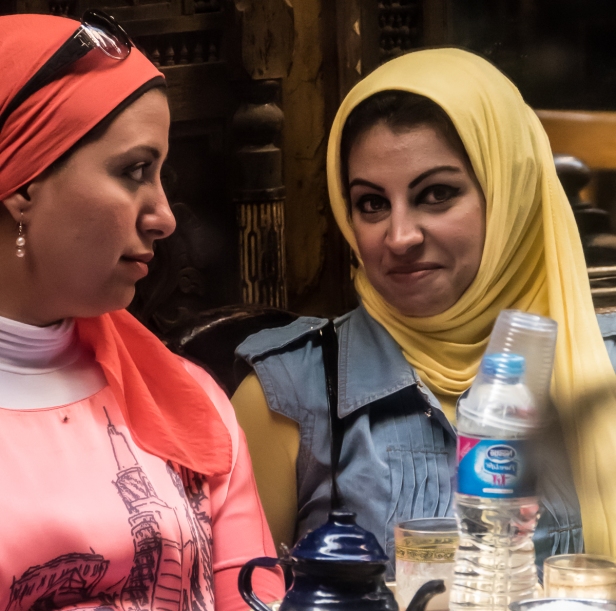
The shoeshine men hassle us for business and some of our group oblige,
and a street cat curls around the corner and up the stairs, it’s yellow eyes an unspoken plea for food.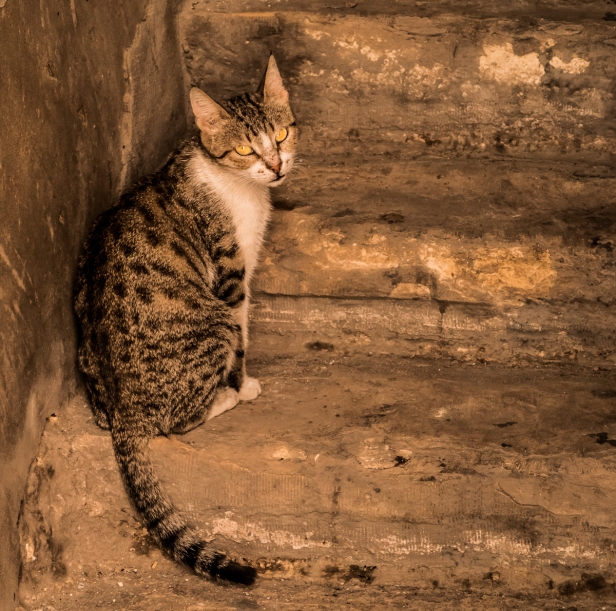
And now we are out of the souk, across the square, and back into the madness.
There are vans that you can hail that run up and down the main streets in the midst of the tsunami of traffic, but you must have exact fare, and know when to get off. We are all heading out for a meal and are grateful for our guide who knows the city well. She knows how to negotiate the price, and she knows where we are going. She flags down a van and we all pile in. Seatbelts? What are seatbelts?
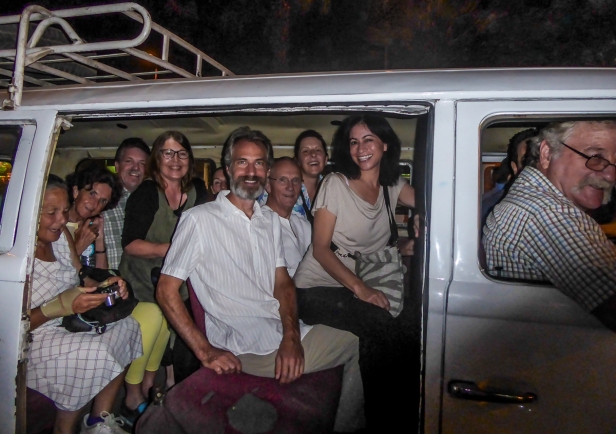
Continuing our journey we explore Old, or Coptic, Cairo, home to Cairo’s Coptic Christian community. The Coptic Orthodox Church dates back to its founding in 42 CE and is arguably the oldest Christian denomination. The church has survived, even being in the midst of a largely Muslim population for the past thousand years, and despite centuries of persecution. Today there are about twelve million Copts in Cairo, and several beautiful churches.
Saint Virgin Mary’s Coptic Orthodox Church, known as the Hanging Church, is built on top of an ancient Roman fortress, its nave suspended over a passage.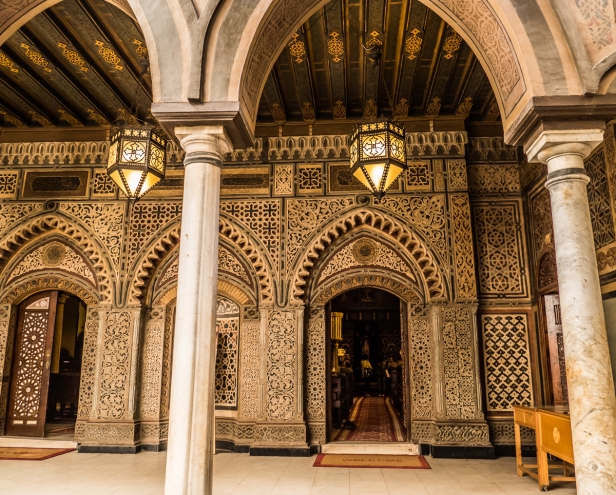
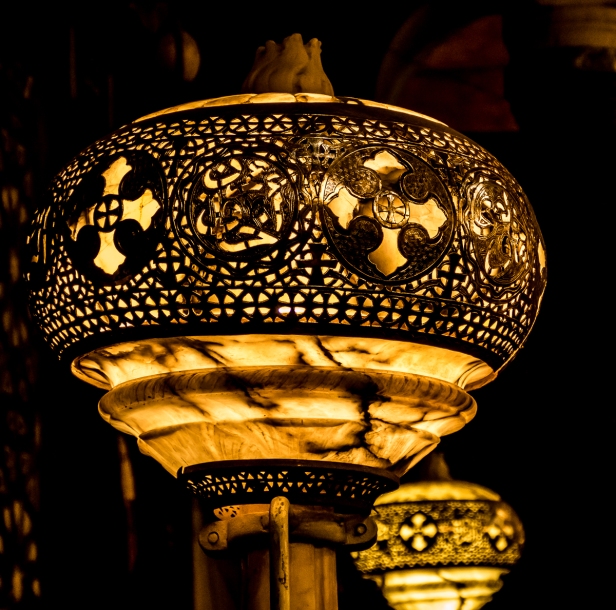

Nearby is the Greek Orthodox Church of St George.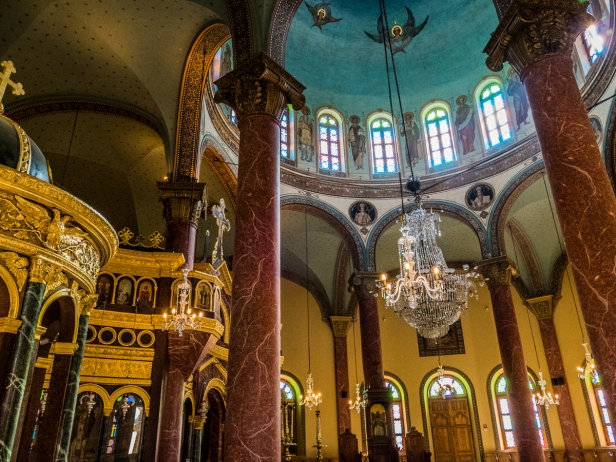
We feel almost as if we’ve been transported to a different city, and a different time. The narrow alleys of the area seem like an island of quiet and peace.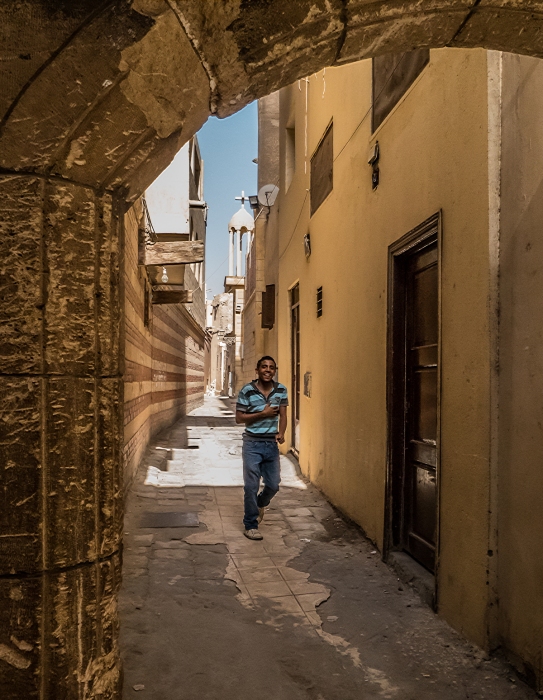

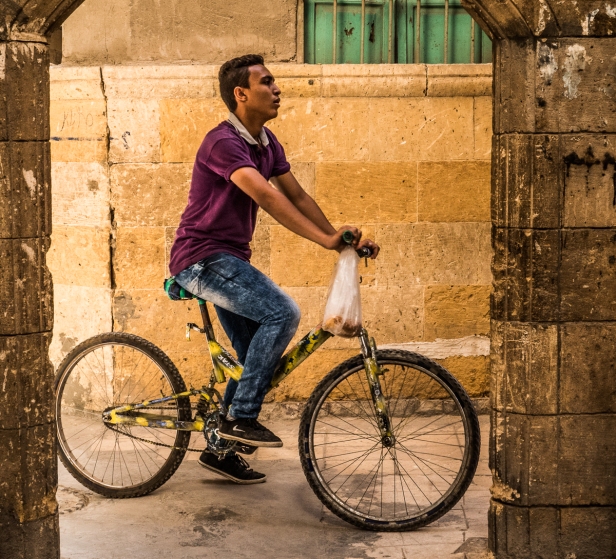
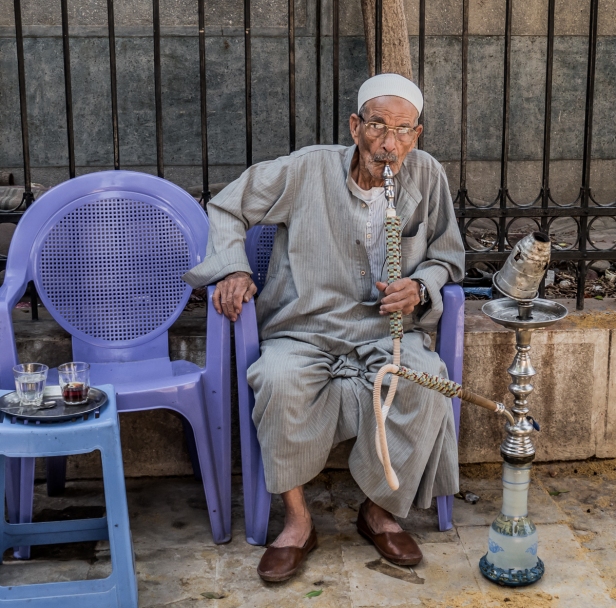
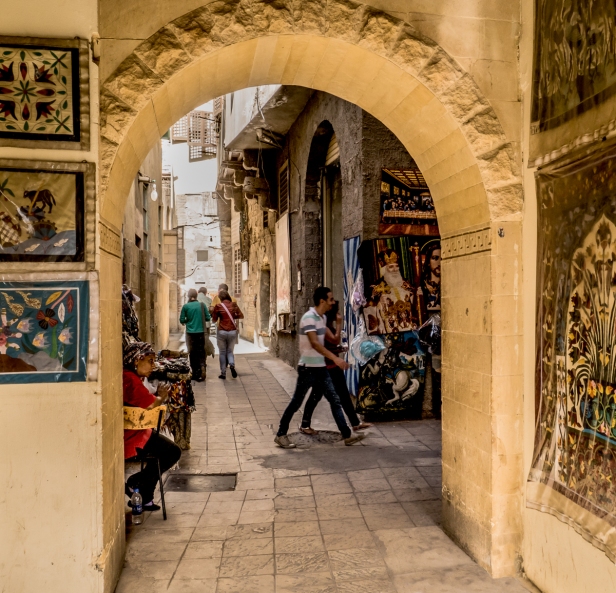
The Arabic name for Cairo is Al-Qahira. Drop the “al” and let Kahira roll quickly off the tongue. It sounds like the Anglicized Cairo. It means the vanquisher, or the oppressor. The Coptic name for the city is Kahire, meaning “Place of the Sun”. We discover that Cairo lives up to both its names. It is one of the most polluted cities in the world, and the crowds and traffic can be overwhelming. At the same time there’s pulsating life here; life that’s exciting and stimulating. There’s beautiful architecture, friendly people, and gems like the Al-Fishawy Café. Somehow the people of Cairo manage to make it work despite the dirt and the over-crowding. It’s a vibrant ever-evolving tapestry, a whole that seems to be greater than the sum of its parts. If you’re willing, Cairo will beguile you into loving it.
This is the final post about Egypt. From Cairo we flew back to Canada, spent two months in Vancouver, and then went south to Mexico.
Other posts about Egypt:
If Ever There Was a Time to Visit Egypt it is Now!
The Riddle of the Sphinx and the Enigma of the Pyramids
Alexandria: An Exotic Blend of Adversity and Affluence
Egypt’s Southern Gateway: Aswan and the Temple of Isis
Sacred River From the Stars: the Eternal Nile.
God Kings and Crocodile Gods: Egypt’s Abu Simbel and Kom Ombo
The Nile, Forever New and Old – Cruising From Aswan to Luxor
Taken for a ride in Luxor. And the Biggest Religious Building of all Time.
Next post: San Miguel de Allende, Mexico
All words and images by Alison Louise Armstrong unless otherwise noted
© Alison Louise Armstrong and Adventures in Wonderland – a pilgrimage of the heart, 2010-2016.

Amazing Photos! Egypt looks incredible
LikeLiked by 1 person
Thanks so much Evelina. Egypt really is amazing!
Alison
LikeLike
It surely looks like it. Your pictures remind me of my travels in Morocco and Tunisia, I see similarities. 🙂
LikeLiked by 1 person
Great writing and beautiful photos! Thanks for sharing your journey.
LikeLiked by 1 person
Thanks so much Nicki. It was a wonderful journey. It gives me great pleasure to share it.
Alison
LikeLiked by 1 person
Simply wonderful glimpses of my Cairo. I did my masters degree at the University of Cairo. Thanks for the memories.
LikeLiked by 1 person
Thanks Peggy. It must have been amazing to live in Cairo. We only got a glimpse. What were you studying?
Alison
LikeLike
I have always wanted to visit Cairo and I hope that I will sooner rather than later. But for now I am grateful to catch a glimpse of Cairo via your beautiful photos and eloquent description. I hope you are enjoying Central America?
LikeLiked by 1 person
Thank you so much Gilda. Cairo was a wonderful experience, even with the crowds and chaos. We’re not yet in Central America. We’re still in Vancouver. We head south Oct 31st. I’m looking forward to the warmth.
Alison
LikeLike
Say it ain’t so! I could read about Egypt for ever. 🙂 I mean, Vancouver and Mexico will be exciting too, but not quite in the same way. Thank you for taking us on your journey through Egypt! Definitely confirmed some things I suspected about how I’d like to travel there, and added some new places too!
LikeLiked by 1 person
It’s so. I finally got to the end of reporting our journey in Egypt. It was an amazing time. I definitely recommend it. It’s a fabulous country. Also I’m glad we did a tour there if only for ease of movement. And it was lovely having someone take care of things for us even if we may have lingered in some places if we’d been travelling independently. The tour also helped us feel very safe.
Alison
LikeLike
As always, beautifully written with gorgeous photos. Thank you.
LikeLiked by 1 person
Thank you so much Anne. It’s a great pleasure for me to share it all. Egypt was such an amazing experience.
Alison
LikeLike
I too, could be beguiled by this fascinating city with its history and intrigue and your photos only tempt me more! Loved the pictures of the ornate churches (that really illustrate what a sanctuary should be) and the quiet streets that contrast with the overwhelming numbers of people on the busy avenues. As always, though, your photos of the people are the things that make me feel as though you’ve shown what the heart of the city is all about. Anita
LikeLiked by 1 person
Thanks Anita. Cairo is such a city of contrasts. In the Coptic Quarter it really felt like we were in a different place, and that souk was amazing. Then the other areas we were in the traffic was overwhelming. I love photographing the people – and they were all really friendly.
Alison
LikeLike
A wonderful series on Egypt, Alison and Don. And Cairo is an appropriate wrap-up. I am always amazed by how much can be crammed into market places. I like to shut off my mind and just wander, making it a meditation.
I was amused by the running shoe the shoe-shine man appears to be about to shine. How in the heck do you shine a running shoe? 🙂 Thank you for the trip through Egypt. –Curt
LikeLiked by 1 person
Thanks so much Curt, I’m glad you enjoyed it. I have had a great time putting together the Egypt posts, which is not to say it was always easy, but that only adds to the sense of accomplishment. Egypt was such a wonderful experience for me on so many levels. I too an constantly amazed by the amount of *stuff* in local markets, particularly the tourist markets. I’m too busy photographing to meditate 🙂
A couple of the guys had their shoes “shone” including Don. They came back nicely buffed with some black added I think to the rubber edging.
Alison
LikeLike
I understand the too busy with photography to meditate! 🙂 Unless, of course, there is a way to turn the photography into a meditation. Not very likely. As for shining tennis shoes, cute, especially adding black to the rubber edges. –Curt
LikeLiked by 1 person
Visiting a big, crowded, chaotic city can be intimidating. But you’ve still found lots of nice little slice of life vignettes that personalize the chaos. And I suspect “window shopping” in the souk would be mind expanding.
LikeLiked by 1 person
Thanks Dave. I’m always looking for the vignettes – it’s the people that are at the heart of the matter every time. Window shopping was definitely an experience, and we were there on a quiet day when many shops were closed. The amount and variety of stuff was amazing.
Alison
LikeLiked by 1 person
Another fabulous read with excellent photo’s. I always love to wander around the streets and look at the intricate detail on the old buildings. Initially they can look old and shabby but look closer and you find the most beautiful ornate detail.
Once again, thanks for sharing.
LikeLiked by 1 person
Thanks Jo. I too love looking at the detail in the architecture – beneath the wear and tear there is great beauty to be found. And you’re welcome! I’ve loved sharing about Egypt.
Alison
LikeLiked by 1 person
Thank you for sharing these amazing photos that show us a birds eye view.
LikeLiked by 1 person
Thanks Jenna, and you’re welcome. It’s been great fun putting all the Egypt posts together.
Alison
LikeLiked by 1 person
You certainly saved (one of) the best for last! You’ve covered so much ground here (in both ways), I hardly know where to begin commenting. For once, I’ll keep it short and just say the entire series on Egypt was exciting reading and viewing. (Your felucca photos will always be among my favorites of all time.) You did that crazy country justice and indeed beguiled me and countless other readers! Bravo!
LikeLiked by 1 person
Thanks so much Lex. I too feel this is one of the best of the Egypt posts (along with the first, and the two about the Nile, though you may have other ideas). I’m glad I beguiled you with Egypt. It’s truly amazing, and so worth visiting.
Alison
LikeLiked by 1 person
Beauty and chaos tangled together. An extraordinary tour which I have enjoyed very much.
LikeLiked by 1 person
Thanks Sue. I’m glad you’ve enjoyed the tour of Egypt. I loved putting it together – I had so much to say! And I was lucky enough to get a couple of photo editing lessons from my sister (a professional photographer) which seriously improved the photos on two of the posts. I love it whenever she’s in town – I always learn so much.
Alison
LikeLiked by 1 person
This is such a fascinating post. Myself living in a rural part of Canada, I can’t even imagine that many people living so densely. The pictures were incredible, capturing the people and architecture in a vivid, beautiful way.
I found the “Canada Dry” part very intriguing and whether or not the people know about our soft drink, the associations there are in different parts of the world is pretty cool.
I found your blog through your comments on Sue and Dave’s
travel Tales”. You have a very content rich blog here! 😉
~Carl~
LikeLiked by 1 person
Thanks so much Carl. I’ve lived in small town Canada for many years – way north both in and close to the Yukon. It’s a very sparsely populated part of the world so I know what you’re talking about. I can’t imagine living in that kind of density either. Nor would I want to. I need nature too much. I was so amused by the shouts of Canada Dry. I did actually ask one of the guys who said it and he had no idea what it was. I hope you enjoy the blog.
Alison
LikeLiked by 1 person
Wow, the Yukon. That is amazing. Thank you for your generous reply. It is much appreciated.
LikeLiked by 1 person
I’m pretty sure I’m related to Al Fish-awy!! Cairo traffic…yuk…”all you wish it wasn’t” is exactly right on. The problem for me is that people from Cairo come to this part of the world and drive the same way they do in Cairo…which isn’t cool anywhere but Cairo, where it’s a necessity to weave where you need to. Your photos are your usual outrageously awesome, but I particularly (for some reason?) like the one of the couple with the guy sipping a pepei, and the old woman moving in the opposite side of the frame. And Don’s photo of the building is so…hmmm…Cairoean. One thing that bothers me is that you’ve brought it to my attention that I didn’t get to the souk in Cairo, and sometimes those are the best of the best in a city.
LikeLiked by 1 person
Thanks BF. I can’t imagine transporting the Cairo driving technique to another city – except perhaps anywhere in India where it is equally insane. I had fun putting together this lot of photos. Quite a bit of editing went on. I’m thinking of doing a blog post about photo editing – I’m not a purist 🙂
The souk was amazing! You’d better go back to see it 🙂
Alison
LikeLike
Alison…that is funnier than you know because we also have Indians here who drive the same way!! They come at your from all directions. And I’d love it if you did a post about editing. Or at least write me a message!! My camera has some settings that make odd pictures, but I can’t control it at all.
LikeLiked by 1 person
Oh I doubt I could control your camera either. And I’m no expert editor, though I guess I’ll include bits about how I adjust highlights/shadows/saturation/clarity etc. I suppose I could go a bit more technical than I’d originally planned. The post will be more about what I clone out, and why 🙂
Alison
LikeLike
Well, yeah, that would be a good post. But I think you are an expert editor… you have an eye for just the right amount. What version of LR do you use? I have LR4 (but don’t know how to use it), is it worth upgrading to CC or are they similar? I hear CC needs much more space on your laptop?
LikeLiked by 1 person
I’ve never used any version of LR but CC so I can’t compare, or help you with LR4 😦
I’m still learning stuff from my sisters.
A.
LikeLiked by 1 person
My gut tells me to go with CC, but my laptop memory (750 gb) is FULL. Full…I’ve got copies of copies of copies of photos on it. I’ll have to waste weeks of searching to get rid of the files.
LikeLiked by 1 person
Have fun 🙂
LikeLiked by 1 person
Thanks so much for this article. I lived in Cairo for a year and your photos brought back wonderful memories. The sights, the sounds and the smells! The Egyptian people are wonderful and they were so kind to us. “Canada Dry” made me laugh as I heard that so often. And, oh, the traffic! I don’t miss that, but it was entertaining.
LikeLiked by 1 person
Thanks Jamie, and you’re welcome. It must have been amazing to live in Cairo. We only got a glimpse, but it was enough for a little taste – of friendly people, and some of the quieter places, and the buzz of the city.
Alison
LikeLike
Wow Cairo looks like a very exotic place!
LikeLiked by 1 person
Yes it’s very exotic, at least to us westerners it is. I imagine to Egyptians it’s all rather ordinary. I loved it there. Egypt is an amazing place to visit.
Alison
LikeLiked by 1 person
What a great post. I was pleasantly surprised with Cairo and really enjoyed it. Sadly, i never made it over to Coptic Cairo or Islamic Cairo and your photos make me understand what I missed! Next time.
The Al-Fishawy Café looks so cool. Looking forward to getting caught up on all your posts now that I am back in Thailand and have fast internet!
LikeLiked by 1 person
Thanks Jeff. I also enjoyed Cairo, especially the souk and Al-Fishawy. Al-Fishawy is very cool! The traffic and the pollution was mind blowing though.
Alison
LikeLike
Lovely photos and a wonderful walk through Cairo. As you said, it is “teeming with life…” We traveled there independently in 2012, and it was pretty void of tourists, which made our experience in Egypt not the best. We were hassled at almost every turn by touts and people who were genuinely desperate. It was very sad to see, but also impossible to deal with, as was the constant, subtle and not so subtle, sexual harassment by the men there (whether I was walking next to my husband or not!) It’s tragic in a way, that a country so filled with incredible things to see and experience, should also have these not to incredible things wound up in it too. But tis the nature of life, I suppose… 🙂
LikeLiked by 1 person
Thanks Shelley. We also found Cairo, and all of Egypt, devoid of tourists so the people affected by that were pretty desperate, but perhaps because we were travelling in a group we were not harassed that much. And I guess I’m just too old to be sexually harassed, though there were young women in our group. Perhaps they were okay because of being in a group. Sorry to hear it was not such a good experience for you. Others have commented in the same way, but except for the horse-and-buggy driver and the kid in the market in Luxor we found the people to be generally friendly and welcoming.
Alison
LikeLike
Hi Alison, I have been meaning to read this since you first posted it. It’s great. The photos are wonderful. It is such a crazy and interesting city. And Egypt is amazing. You have done a wonderful job of representing it well and enticing people there. I will have to check that I haven’t missed any in this series of posts. Louise
LikeLiked by 1 person
Thanks so much Louise. Yes – a crazy interesting city. I wish we’d had more time there. Egypt was an amazing experience for me. I’m so glad I finally got there.
Alison
LikeLiked by 1 person
Fabulous photos and commentary, as always, Alison. But my heart went out to those poor little donkeys, straining under their heavy loads. They looked so sad and tired. Bless them all.
LikeLiked by 1 person
Thanks so much Isabella. Oh those poor donkeys! I saw some being whipped along too. It is the same in many third world countries I think. But I must say that Egypt was still an amazing experience and I’m so glad we went there. It was wonderful in so many ways.
Alison
LikeLiked by 1 person
Alison, I love that last line about being beguiled! I can’t wait! Looks exotic and gritty and fascinating. Perfect! And Canada Dry… that’s hilarious. Hope you’re settling into Mexico and happy to be back on the road. xo K.
LikeLiked by 1 person
Thanks Kelly. Yes, Cairo is exotic and gritty and fascinating – good description. And definitely worth seeing. Haven’t gotten round to answering your email yet – had my head in figure skating competitions all weekend – but we don’t leave until the end of the month Oct 31. Good thing since we’re not remotely organized.
Alison
LikeLike
Omg, I love that you’ve been lost in figure skating competitions! What fun. Sorry – thought you were leaving on the 1st. I’ve had my head in work for the past couple weeks, and coming up for air now, dazed and confused! 🙂
LikeLiked by 1 person
thank you for vividly expressing
this ancient mother of the world
with such clarity and beauty.
my heart is moved by the humanity
and feels compassion for the dense poverty.
may they all find comfort & ease in
their own way.
this was an enjoyable holiday
i’m happy to have glimpsed
and hear of the refreshing canada dry beverages
to cool the warm, thick air 🙂
LikeLiked by 1 person
Thank you David for journeying with me
to Egypt and the Mother of the World.
My heart is moved also yet there is joy as well
in these many ordinary lives I’m sure. I see
their ready smiles welcoming us.
I fell in love with this country.
Alison
LikeLike
You capture the timeless beauty of Cairo with this post ~ I am in love with the feeling of the air and places you described. I loved Cairo, the people and truly an exotic feel for me as such tremendous achievements and history came from this wonderful place…and recent history has been less kind. The ambassador you are to this world is a great comfort, both living vicariously through your words/photos but knowing you leave a great impression on those you pass & meet in your travels.
LikeLiked by 1 person
Thank you so much Dalo. I too loved Cairo, and all the places we visited in Egypt. I’m sure it will remain one of the highlights of all our travels. I feel as if the very molecules of the air contain the thousands of years of history. It’s impossible to not be moved by such a place. It seeps into your bones. I sing Egypt’s praises to everyone who will listen. Thank you for commenting.
Alison
LikeLike
You mention the one thing I loved as well ~ wondering how much of the history was floating up around me, in the food I ate and air I breathed…it was quite exciting. Egypt is an amazing place ~
LikeLiked by 1 person
Hi Alison and Don, I am very grateful to see this glimpse from Cairo. I’ve read the bible about Egypt but not knowing what it really looks like. Good thing I came across your site.Pleasure to read your article. Thanks
LikeLiked by 1 person
Thank you so much Faye, I’m glad you enjoyed it. Egypt is a remarkable and wonderful country, rich with history, and friendly people. We loved it.
Alison
LikeLike
Without your eloquent words you tell such a compelling story with your photos Alison. Add to that your intriguing prose and I am spellbound. I loved each and every post from Egypt. So happy to have strong internet today and more than a few minutes to sit quietly and enjoy this post.
LikeLiked by 1 person
Thanks Lu Ann, what a lovely compliment. I had fun writing about Cairo, there was so much going on there, and of course so much to see. My camera just wouldn’t sit still! All of Egypt was like that. I’m glad you enjoyed the series. It was definitely one of the highlights of our travels.
Alison
LikeLiked by 1 person
Fabulous! I’ve been saving this one in my inbox until I had time to read it. Wow, would love to make it to Egypt someday. You’ve been to some amazing places Alison.
LikeLiked by 1 person
Thanks Nicole. Egypt was truly amazing – one of my favourite places.
Alison
LikeLike
These photos are beautiful! I appreciate how they capture an authentic spirit of the city- the people going about their day and the buildings are wonderful. I especially liked Saint Virgin Mary’s Coptic Orthodox Church, it is now on my must-see list!
LikeLiked by 1 person
Thanks so much Caitlin. Cairo is an amazing place, with much to see and experience.
I loved photographing the people there. St Mary’s is definitely worth seeing – very beautiful. And Al-Fishawy’s and the souk are both fabulous.
Alison
LikeLike
Nether thought Cairo could be so enticing, I might pay a visit to it in the very near future then!! Thanks for the journey,
Fabrizio
LikeLiked by 1 person
Thanks Fabrizio. Cairo was fascinating. Chaotic, but so many areas of interest and richness. It’s a lot to take in, but definitely worth visiting.
Alison
LikeLiked by 1 person
What fabulous pictures! Especially in the bazaar!
We traveled to Egypt in 2012, right after the Arab Spring. At that time they were struggling with the garbage pick-up management. Is it better now?
LikeLiked by 1 person
Thanks so much. I loved Egypt!
We were there in 2015. I’ve been putting up old posts on NSYFTB. I didn’t particularly notice a garbage problem, not like India anyway! (But then there’s nothing quite like India!)
Alison
LikeLike
Wow I love this architechtual magic, I would love to see it in real life 🙂
LikeLiked by 1 person
Isn’t it fabulous! Egypt is one of the most fascinating places we’ve been to, and one of the highlights of all our travels. The whole trip was just amazing. I hope you get there one day!
Alison
LikeLike
There is so much culture and history here – such a wonderful city to explore and get to know. Looks like you did just that. I have been wanting to go to Cairo and now your experience has only made it so much more of an aspiration for 2020.
LikeLiked by 1 person
Cairo is quite fabulous, as is Egypt. We had 2 weeks there, 12 days of that on an Intrepid tour. The whole thing was an absolute highlight. Hope you get there one day!
Alison
LikeLike
Alison, this is a wonderful photo essay on “The Real Cairo.” There are few things one can experience abroad that feel more exotic than a maze-like souk with its jam-packed alleyways, unusual smells, and constant hum of life. The vendors and their never-ending ways to hook foreigners are also priceless. I love your “Canada Dry” story. When we say we’re from the US, they usually ask where. And then when we say Kentucky, they say “Kentucky Fried Chicken!” 🙂
This is a great, real-world glimpse of Cairo that should be required reading for anyone who wants to visit. I’m sure your readers will enjoy it. ~James
LikeLiked by 1 person
Thank you so much James. I agree re souks – they are always the most interesting and exciting places.
Oh too funny about the Kentucky Fried Chicken. But both your story and mine show the relentless far reach of corporate advertising.
Cairo was extraordinary. I know it reads as if it was one day but the experiences and images came from several days there – there was so much to take in! And this apart from the Sphinx and pyramids!
Alison
LikeLiked by 1 person
An extraordinary city, and one that I don’t think I could ever feel comfortable with. Thanks for taking me there, Alison. I feel sure that living in such close relations has meant Cairo being badly affected by Covid-19.
LikeLiked by 1 person
My pleasure Jo. It is indeed an extraordinary city, and definitely one worth visiting if only for the pyramids and the museum, but I’m not sure I’d have felt comfortable either without a local guide who knew the city inside out. We explored the souk and coptic quarter alone, but everywhere else we had our trusty guide with us. Honestly now I’m thinking of it I imagine I’d be totally intimidated to try to get around Cairo without a guide.
I don’t know how it is with the pandemic. Probably not good 😦
Alison
LikeLiked by 1 person
So very glad you linked this post to the one written by James and Terri of Gallivance. This is an amazing city, and your photos are equally amazing. I was supposed to go to Jordan and Egypt this past March, but the pandemic cut that trip out completely. Don’t know if I’ll ever be there. But some of what we saw in Morocco is similar. You were lucky to capture the picture of the ladies in black dress — We were told not to take those in Morocco, and some women ducked if they saw us with cameras. The souks are quite similar to those in Morocco — and the traffic. Again, I love this post, and I hope you are planning more travel soon.
LikeLiked by 1 person
Thank you so much. I’m so glad you enjoyed it. I found Cairo to be an absolutely extraordinary city. Well all of Egypt really. The 2 weeks we had there was definitely a highlight of all our travels. I was in the Fez Medina years ago, and yes now that you mention it it is similar to the souk in Cairo. That’s so sad that you missed out on your trip to Jordan and Egypt 😦 I hope you get there one day. Jordan’s pretty amazing too.
Alison
LikeLiked by 1 person
Someday . . . Maybe.
LikeLike